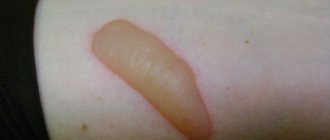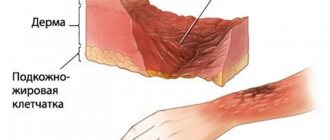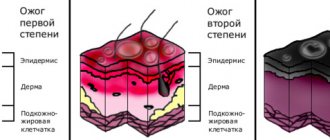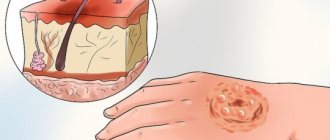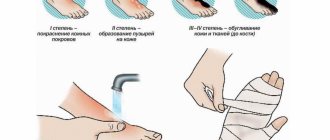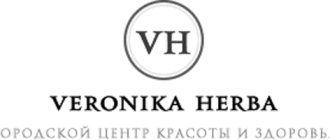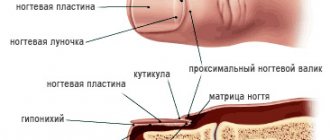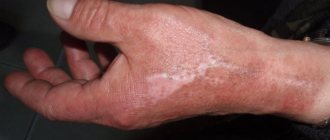Classification of injury
To determine what treatment is necessary, you need to briefly describe what degrees of damage are distinguished:
- First degree burn . Redness, slight pain and swelling appear in the superficial layers of the epidermis.
- Thermal wound II degree . Severe redness, swelling, detachment of the damaged layer, formation of blisters filled with yellow liquid. The affected area heals in 11-15 days, skin pigmentation can persist for 2.5-3 weeks.
Wounds of the first two degrees are considered superficial. Their treatment is possible on an outpatient basis. They are able to heal with conservative treatment.
- IIIA degree burns are accompanied by damage to the epidermis and dermis. A light-colored scab forms. Beneath it there are noticeable pink areas - the papillae of the dermis. As the scab moves away or changes, areas covered with epithelium appear in patches. Recovery occurs after 3-6 weeks. The result is a rough scar.
- IIIB degree : skin damage, muscles are often injured. The wound is cleared of dead tissue after 4-6 weeks.
- IV degree is the most prognostically unfavorable and severe. These injuries affect the fascia, muscles, tendons and bones. The scab is thick and charring may occur. Possibly accompanied by purulent complications such as arthritis, abscesses and phlegmon.
Lesions of IIIB and IV degrees are deep wounds that require hospital stay and surgical treatment, as well as the issue of skin restoration using skin grafting. It is necessary to seek specialized help and rational treatment from appropriate specialists without delay.
Lesions of IIIB and IV degrees require hospital stay and surgical treatment.
Types of burns
In addition to the degree, for proper first aid and further treatment, it is necessary to take into account the cause of the burn: fire, steam, aggressive chemical compounds, etc.
- Thermal burn - the most common type, resulting from contact with fire or high temperature substances. Main subspecies:
- Fire burns manifest themselves as sharp pain, burning, and redness of the skin.
- Burns from boiling water - in addition to pain and redness, they are accompanied by swelling and blisters with a light, transparent liquid. The surface of the bladder is tense; when it ruptures, a wound opens, which is then covered with a scab. This type is dangerous primarily due to infection of damaged tissues.
- Steam burn - in the initial stages, the symptoms are the same as in the previous type, because Steam is evaporated high temperature water. Such burns occur in the kitchen or while cleaning. More serious degrees of injury occur during accidents at enterprises, failure to comply with safety regulations, etc.
Complications
A more serious condition in the case of deep burns occurs if they occupy more than 5-11% of the body or the total burn area is more than 20%, then in this case burn disease occurs. This disease is associated with loss of skin and profound impairment of their functions (protection against infection, loss of pain and tactile sensitivity, maintaining water balance, thermoregulation). A serious condition requires a systematic approach and comprehensive treatment aimed at preserving the life of the victim, being in intensive care conditions and a multidisciplinary approach of specialists. It is important to note that for children under one year old, 3-5% of the burn area is sufficient for this complication to appear.
Dermatologist Natalia Sirmais has prepared an article about what first aid should be for a burn. Everyone needs to know these recommendations.
Burns are one of the most common injuries sustained at home. Burns can come from:
1. Temperature effects
2. Irradiation
3. Electricity
4. Chemicals
At home, the cause of a burn is usually: boiling water, an unsuccessfully left kettle, a plate of hot soup that a child’s hands have reached.
Of course, it is better to prevent such a development of events, but absurd accidents can happen to anyone. Shouting about “why didn’t you follow up” and “how could this happen” will not help matters. It is better to always be fully prepared and know the algorithm of action if an unpleasant situation does occur.
It is important to avoid panic and take action immediately. The depth and area of the lesion, and later the recovery time, depend on the speed with which assistance is provided.
Burns are divided into 4 degrees, but the 4th degree of damage from boiling water is very rare.
- With grade 1 lesions, only the upper layers of the skin are damaged, accompanied by redness and slight swelling.
- Stage 2 is characterized by the appearance of blisters filled with cloudy liquid. Severe pain often occurs. If first aid is provided promptly and correctly, scars and other skin changes can be avoided.
- In grade 3 injuries, red wounds are visible, dead tissue appears as gray or dark scabs, and both skin and muscle tissue are affected. The blisters are filled with bloody or cloudy contents, the person experiences severe pain, and shock may develop. In this situation, hospital treatment is required.
- The 4th degree is accompanied by deep damage to the skin, muscle tissue and even bones (even with their charring). This is an extremely serious condition. Immediate hospitalization is required.
What is prohibited to do:
1. Immediately after a burn, apply oils, fats and ointments to the skin. A greenhouse effect may occur: excess heat will not be able to leave the skin, thereby increasing the affected area, even to the point of tissue infection.
2. Treat with solutions containing alcohol. This will increase the pain and lead to the death of some of the damaged cells.
3. Cool the burn with ice. This will cause frostbite and tissue death rather than cooling.
4. Puncture blisters. This can cause infection in the wound. Small blisters do not require puncture, since they contain a sterile liquid inside, which does not allow infection into the wound.
5. Sprinkle with flour/starch, apply grated potatoes, compresses with urine, smear with kefir/sour cream, use toothpaste or raw eggs. Such methods will not help with a burn, but can easily cause harm.
6. Trying to tear off clothing or other materials that are stuck to the skin - this can lead to the removal of skin as well.
In what cases is an ambulance/visit to a doctor required:
1. If a child or an elderly person is injured, and the burn area is larger than the palm of an adult.
2. If the damage is deep, burns are 3-4 degrees, regardless of area.
3. If large bubbles appear.
4. For burns of the face, eyes, and perineal area.
5. If signs of tissue infection appear
6. If you lack the skills and strength, provide assistance for these injuries.
- So, let's move on to the stages of providing first aid:
1. Take off your clothes. Don't waste time, tear or cut the fabric. If it sticks to the skin, do not try to peel it off. Avoid bubbles if there are any.
2. Place the affected area under medium pressure of cold tap water. If possible, refill the container if the foot or hand is affected. This will help reduce pain and relieve swelling, cool the damaged areas and tissue around the lesion.
If the skin is severely damaged, if it is peeling, you need to cool it through a wet cloth, this will reduce the pain from direct contact with water.
Cool the skin for 10-15 minutes.
Please note that this is the most important help point! This method, despite its simplicity, can reduce the depth of the lesion by an entire degree (from the second degree to the first).
3. Starting from the second stage, it is necessary to give painkillers.
4. For a minor burn, after 15 minutes, blot the damaged area with a lint-free cloth, then apply a sterile non-woven bandage or cover the burn with a clean cotton cloth, if nothing else is available (do not press or rub, especially if there are blisters).
For 1st degree burns, a bandage may not be necessary, then apply aerosol foams (olazol/panthenol) more often, but first thoroughly cool the damaged area.
5. If indicated, consult a doctor. Remember that qualified and timely provision of medical care contributes to a significant improvement in the victim’s condition, reduces/prevents the risks of infections, and also accelerates further recovery of the body.
First aid for a thermal wound
First of all, when you receive a wound, you should not panic. If you are at home, to alleviate the condition, it is enough to immerse the affected areas in cold water until the pain stops . In case of a burn, your first aid kit should have the following items:
- Panthenol 5% in the form of cream or aerosol. Among the agents that can improve microcirculatory disorders and wound cooling, 5% water-soluble anilocaine ointment “Anikol” is also used. The use of antioxidants, for example Soderm ointment, vitamin E promotes faster recovery of the affected skin area.
- Sterile bandage to cover the wound.
- Hydrogen peroxide 3% or another antiseptic if the burn also causes contamination of the wound. Important! If the wound comes into contact with the ground, vaccination against tetanus is necessary.
Treatment of chemical burns
To provide adequate assistance, it is necessary to know the type of chemical damaging agent. Indeed, in most cases, in order to eliminate the substance, repeated rinsing of the affected area with water is recommended (for 10-30 minutes). But if damaged by quicklime, water is prohibited; the burned area is washed with oil.
Next, it is necessary to neutralize the chemical substance remaining in the tissues. For acid burns, apply lotions with 2% soda, irrigation with 0.1% ammonia solution (15 drops per glass of water), 1% lime water, powder with chalk or burnt magnesia. To neutralize alkalis, use 2% solutions of hydrochloric, acetic, boric, and citric acids. Phosphorus is neutralized with 2% copper sulfate. Next, the burned area is covered with a sterile bandage with panthenol, syntomycin emulsion, Shostakovsky balm, solcoseryl or sea buckthorn oil (depending on the degree of the burn and other features). Subsequent treatment tactics are identical to the management of thermal burns.
In case of acid burns, the necrotic scab disappears after about 10 days. As a rule, in this case, scar deformities are not observed. Damage from alkalis is often accompanied by granulating wounds, which heal slowly and lead to the formation of rough scars. To prevent scar contractures on the extremities, it is recommended to apply plaster splints until the wounds are completely healed. After this, regular gymnastic exercises and a course of physiotherapeutic procedures (electrophoresis with lidase, etc.) are necessary.
With extensive wound surfaces and the development of disfiguring or movement-impairing scar deformities, patients require additional surgical interventions.
Modern headbands
There are a huge number of new dressings that can be used at home to promote rapid healing. The main difference from a regular bandage is that they create a favorable microclimate in the wound. After all, if the affected area of the skin dries completely, it will not speed up healing.
Branolind N with Peruvian balsam
The patch has a specific odor; it is used for wounds of 1-2 degrees; it cannot be used for necrotic damage. You can change the bandage once every two days. A contraindication is an allergic reaction to the patch, manifested by redness and swelling.
Hydrocoll
Gel dressing, which is used for 1-2 degree burns. The package contains a 15x15 cm bandage that can be adjusted to the size of the wound. The bandage should cover the damaged area by 1-2 cm.
Silkoplast Comfort IT-Burn
Used for grade 1-2 wounds, relieves pain and promotes rapid healing.
Causes of chemical burns
Chemical burns can occur at work, at home, or during suicide attempts. They occur when exposed to the following substances:
- acids (sulfuric, hydrofluoric, hydrochloric, acetic, nitric, etc.);
- alkalis (caustic soda, etc.);
- petrol;
- phosphorus;
- kerosene;
- bitumen;
- salts of heavy metals (zinc chloride, silver nitrate), etc.
The insidiousness of chemical burns lies in the fact that tissue damage occurs before the substance is completely neutralized and eliminated. In this case, acid burns are more favorable, since upon their contact with tissue proteins, a scab is formed, preventing further penetration of acids. Alkalis, unfortunately, have a fat-dissolving effect, so they cause deep burns. Phosphorus causes not only serious local tissue damage, but also severe general poisoning.
How dangerous are burns?
First and second degree burns, as a rule, do not pose a significant danger to human health - especially if they are not extensive.
Injuries of the third and especially fourth degrees, without taking appropriate measures, can cause severe intoxication of the body, the cause of which is overload of the liver and kidneys due to the removal of decay products of damaged tissues.
The body's immune defense is disrupted, making it easily susceptible to infections.
Both of these factors lead to exhaustion of the body, and then to death.
